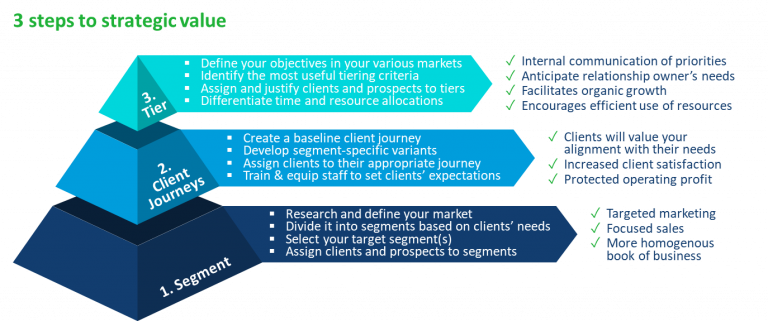Segmentation and tiering status quo
What we did, and why
In Q3 2020, we researched the segmentation and tiering status quo across the B2B asset management industry and the value firms are capturing from it.
To achieve this, we gathered statistically-valid data and perspectives from heads of marketing, product, CX, digital design, relationship management, client service, client satisfaction, and COOs – from across 18 recognisable asset management brands.
We initiated the project after a discussion at a CX Forum meeting about how firms manage the different needs of different clients.
Segmentation and tiering status quo – key findings
About 80% of participating firms tier and / or segment their institutional clients, of which about 30% pointed to gaining strategic value from their arrangements. We defined ‘strategic value’ as trends that improve multi-year profitability. Example include greater organic growth, efficient prospecting, minimised complexity, lower operational risk, and optimised operational costs.
More than one approach was in place across these leading firms, but we believe it is notable that 18% of firms pursue alignment through segment-specific client journeys. This requires a 3-step process of segmentation, aligning journeys to segments, and then tiering. Because the client’s experience is linked to its segment, these asset managers can re-tier clients without significantly disrupting their services.
Regardless of approach, however, the firms that are capturing strategic value each displayed two common features:
- They keep things simple – on average, they have fewer tiers and fewer tiering criteria than the remaining firms that receive less or no value from their efforts.
- They enforce it – they have governance arrangements in place to ensure their segments, journeys, and tiers are adhered to and stay relevant.
A third important aspect of the segmentation and tiering status quo is that 65% of firms have adopted a 2-step process of, broadly speaking, tiering their clients and then designing journeys for them. Typically, they have created a single level of priority (e.g. gold, silver, and bronze) based on both the client’s needs (which is segmentation) and their needs (which is tiering), and then designed client journeys per tier. 75% of them are yet to secure strategic value from doing so.
Implications
These results imply that the way to yield strategic value year-on-year is to come up with a simple plan for aligning your organisation with the needs of its clients and to keep it under review.

These results also imply that prioritising clients and then creating associated client journeys is not very effective. This 2-step approach of providing different client journeys to (unsegmented) tiers creates problems because a client’s attractiveness is not an indicator of its needs: a ‘gold’ insurer will want different things to a gold DC platform.
This approach, therefore, creates a risk of misalignment between a client’s journey and its needs. This is important for two reasons:
- From the perspective of CX, your alignment with what your clients want will drive their impression of your value.
- Where there is misalignment customisations will follow, along with their associated costs and risks.
At Accomplish, we believe the 3-step approach has a massive advantage over the alternatives because it enables the organisation to dial-up and dial-down tiering. This model also combines the ‘best-of-the-best’ approaches in terms of the number of ways it can positively affect multi-year profitability, e.g. to target opportunities, manage retention risks, and allocate resources efficiently.
Lastly, with only 18% aligning experience (journeys) to needs (segments), it appears the industry may be limiting the effect of segmentation by conflating it with tiering – by turning 3 steps into 2.
Final thoughts
We believe the 3-step process is quicker and more effective and that its low take-up across the industry may stem from a lack of clarity around the difference between segmentation and tiering. For example, we found that firms referred inter-changeably to ‘segments’ and ‘tiers’.
The difference is important, though, because as we have seen it is a factor in whether or not you can capture strategic value from these efforts. To not, is to leave money on the table unnecessarily.
We hope you found this research into the segmentation and tiering status quo across the asset management industry useful.
As a discipline, CX is still in its infancy and this is particularly the case in the context of business-to-business (B2B) asset management.
Accomplish is an information services company that is changing this by establishing the case for CX and helping asset managers stand out from the crowd with new tools and standards.



